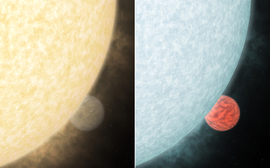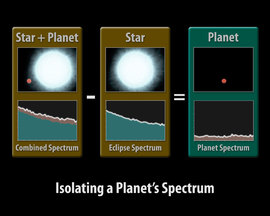Exoplanets
Exoplanets, or extra-solar planets, are planets orbiting stars other than our Sun. The search is on to find a habitable world around another star, where we might find life. Infrared observations help us find these planets, tell us about their size and atmospheric makeup, and can even measure the wind speeds and weather patterns on these distant worlds.
A Home Away From Home
Have you ever looked at the sky and wondered if life exists anywhere else in the Universe? One of the most stirring developments in all of astronomy, and one that might allow us to answer that question with certainty someday, is the on-going discovery of exoplanets: planets that orbit stars other than the Sun.
So far, Earth is the only place where we know that life exists as we understand it, but the hunt is on for an exoplanet that can host life around another star. For that to be possible, scientists think the exoplanet must orbit its host star in an area known as the “habitable zone” (often referred to as the “goldilocks zone”), which is defined as just the right distance from its host star for liquid water to exist on its surface over geological time. In addition, because an exoplanet’s atmosphere would be altered by the presence of life—in a way that only living organisms could alter it—scientists think a potential life-hosting exoplanet would have to have an atmospheric chemistry that matches some stage of the Earth’s atmospheric history.
Finding Exoplanets
Exoplanets are some of the most difficult objects in the Universe to find. They are tiny compared to their host stars, and they are dark, not giving off any visible light of their own. Looking for exoplanets around distant stars is a little bit like trying to photograph a mosquito next to a lighthouse.
Never passing up a good challenge, astronomers have found several clever techniques for finding those mosquitoes. Most of them involve looking for hints of planets by seeing how they affect the light from stars. While astronomers have used at least a half dozen techniques, the vast majority of confirmed exoplanets have been found by either of two different methods that detect how an orbiting planet can affect the light of its star.
Wobble Method
The technical term for this is the radial-velocity method.
The first exoplanets orbiting normal stars were found by looking for tiny wobbles in the star's motion. Newton's law of gravity teaches us that for every gravitational action between a star and an orbiting planet, there is an equal and opposite reaction on the star. So as a star's gravity tugs on a planet, pulling it into an orbit around the star, the planet's gravity also tugs on the star, causing it to wobble back and forth as the planet goes around it.
Astrononomers look for these tiny stellar wobbles by examining the spectrum of the star and looking for slight shifts in features in the spectrum. These shifts indicate changes in the motion of the star, revealing the presence of orbiting planets. From these measurements we can learn the length of the planet's orbit and get a general idea of its mass.
Transit Method
The transit method reveals the physical size of a planet as well as the length of its orbit. It does not reveal the planet's mass, however.
Scientists now think that most of the stars in our galaxy have planets orbiting them, but the orientations of these systems are random. If you imagine that a star is at the center of a dinner plate, and a planet is orbiting in a circle at the edge of that plate, we see some of the systems face-on, as if looking at the plate from above, while others look edge-on to us, like holding up your plate and looking at the edge. Most systems are somewhere in between, which is like angling your plate somewhere between face-on and edge-on. The orientation of a planetary system compared to Earth is called its inclination, and this can have a big effect on whether we see a planet or not.
A small fraction of the planetary systems out there are oriented edge-on, which means that as the planet orbits its star, it passes between the star and us, blocking some of the light from the star as it does so. For these systems, every time the planets pass in front of their star—what astronomers call a transit—a telescope can can detect this tiny drop in the amount of light we see from the star.
By carefully observing a star's brightness over a long period of time, astronomers can create a graph called a light curve. When an orbiting planet transits the star during its orbit it creates a tiny dip. This dip occurs every time the planet orbits its star, so looks like a repeating pattern in the light curve. The size of this dip tells us the size of the planet (in proportion to the size of the star). Since planets are generally tiny compared to their stars, this drop is usually only a few tenths of a percent. Jupiter-sized worlds are easiest to detect, because of their large size, but much smaller Earth-sized planets are especially difficut to see.
Most of the known transiting exoplanets have been found by NASA's Kepler mission. Kepler has stared at a single patch of sky for years, observing the brightness of around 100,000 stars looking for transits.
The tiny changes in the light curve caused by the glow of the planet are miniscule compared to the transit, but in rare cases have been seen—in infrared light.
The animation below shows a simulated light curve and how it relates to the motion of the planet around its star. In addition to the dip in light caused by the planet's transit across the star, there is also a much smaller dip when the planet moves behind the star. A slight ripple in the overall brightness reflects the changing brightness of the planet itself, as we see different views of the day and night sides of the planet as it orbits.
Once a planetary candidate has been detected by the transit method, infrared telescopes like NASA's Spitzer Space Telescope and the Keck Observatory swing into action, taking further observations at their longer wavelengths to confirm the detection. By working together, these telescopes and their different wavelengths of light have been able to confirm over a hundred planets so far. Astronomers believe that this is just the tip of the iceberg, and now think that most of the stars in our galaxy could host planets, meaning that there are billions of them out there, just waiting to be found.
Hot Jupiters
Exoplanets are easier to find—using both the wobble and transit methods—when the planets are big (larger signals) and we see lots of orbits (confirmation through repetition). So the easiest thing to detect would be something as big as Jupiter that orbited its star every few days. However, since there is nothing like that in our Solar System, no astronomer predicted we would ever see anything like that.
In our own Solar System, the planet Mercury orbits the Sun every 88 days. The orbits of hot Jupiters fall far inside the orbit of our hottest planet!
Imagine everyone's surprise when the first exoplanet found orbiting a normal star—51 Pegasi b—weighed in somewhere around the mass of Jupiter, with an orbital period of just over 4 days. Furthermore, subequent discoveries showed this was not a fluke, but a common class of planet around other stars.
The self-explanatory name given to this class of planet is hot Jupiter. And while they are truly an alien kind of world with respect to our local worlds, they become very interesting candidates to study using infrared light.
Because hot Jupiters are so close to their stars, their temperatures can reach thousands of degrees. At these temperatures they glow strongly in the infrared. In addition, the hot stars are a little less bright in infrared wavelengths than they are in visible light. This means that in infrared light there is less contrast between the glow of the star and the exoplanet, which means that it is easier to directly detect exoplanets in the infrared than in visible wavelengths.
Exoplanet Atmospheres
In 2005, Spitzer became the first telescope to allow astronomers to directly detect the light from hot Jupiters. Light curves from two exoplanets, TrES-1 and HD 209458b, clearly showed the signs of the planetary eclipses as they passed behind their stars. This revealed the amount of light coming from the exoplanets, which revealed vital clues to their temperatures and atmospheric properties.
A spectrograph lets astronomers split up light into its various wavelengths, much like the way light through a prism lets us see each color individually. The resulting spectrum can reveal the unique fingerprints of different chemicals.
Astronomers can study more than just the overall brightness of an exoplanet when it is eclipsed by its star; they can also obtain its spectrum. A spectrum is created when we split light into its different colors, in much the same way that a prism splits light into the colors of the rainbow, but down to much finer wavelengths. To capture an exoplanet's spectrum, an infrared telescope has to observe the planetary system twice using a spectrograph. The first time it takes a spectrum of the host star together with the exoplanet. Then it takes a spectrum of just the host star, when the exoplanet has disappeared behind it. By subtracting the spectrum of the host star from the combined spectrum of the star plus the exoplanet, astronomers are able to get the spectrum for just the exoplanet.
The spectra can let us identify the unique fingerprints of materials like hydrogen, carbon, and water. From them we can tell what the planetary atmospheres are made of, even from billions of miles away. Not only that, but astronomers are also able to estimate the exoplanet’s temperature. All of these pieces of information provide scientists with clues as to whether or not an exoplanet might harbor life. While astronomers have found chemical signatures for the building blocks of life on other planets (including carbon dioxide, water and methane), so far we have no clear signal of life on another planet.
Exoplanet Weather
As well as taking a "taste" of an exoplanet's atmosphere, the temperature data we collect can help us tell what the weather is like on an exoplanet. Infrared data taken by Spitzer showed a huge difference in temperature between opposite sides of a hot Jupiter called Upsilon Andromedae b.
The side of the planet facing its star is as hot as lava, while the other side is as cold as ice. Astronomers calculated that planets like this must have some of the strongest winds in the universe, blowing at several thousand miles an hour!
Extremophiles
Extremophiles are found on Earth in high mountain regions, deep dark oceans, highly acidic pools near volcanoes, and buried under miles of ice in underground lakes.
The search for life around other planets has mainly focused on life as we recognize it, in conditions that are similar to Earth. But other forms of life may exist in the universe that we don’t even know how to recognize yet. Scientists continue to discover strange microscopic organisms classified as extremophiles, which live in extreme places on Earth like the hydrothermal vents on the seafloor in Antarctica.
These extremophiles thrive in places that would be lethal to other lifeforms on Earth, such as in regions of high acidity or salt, extremely high or low temperatures, lack of oxygen and a lack of sunlight, to name just a few. The more the more we learn more about extremophiles, and the more exoplanets we discover, the more prepared we are to recognise extremophile life elsewhere in the universe.
Published: 06 August, 2013




